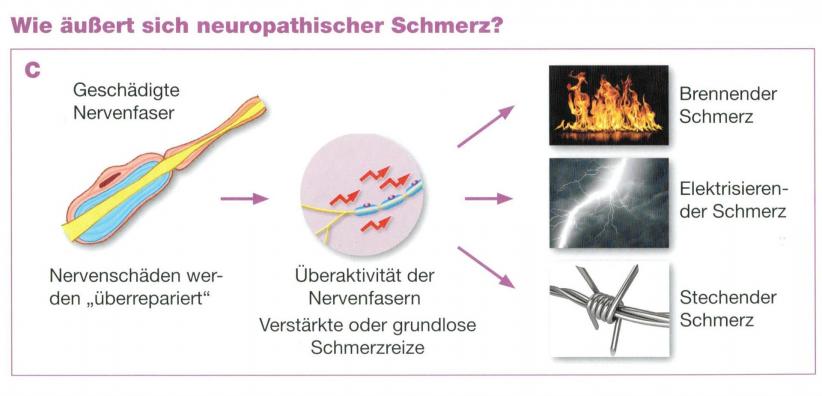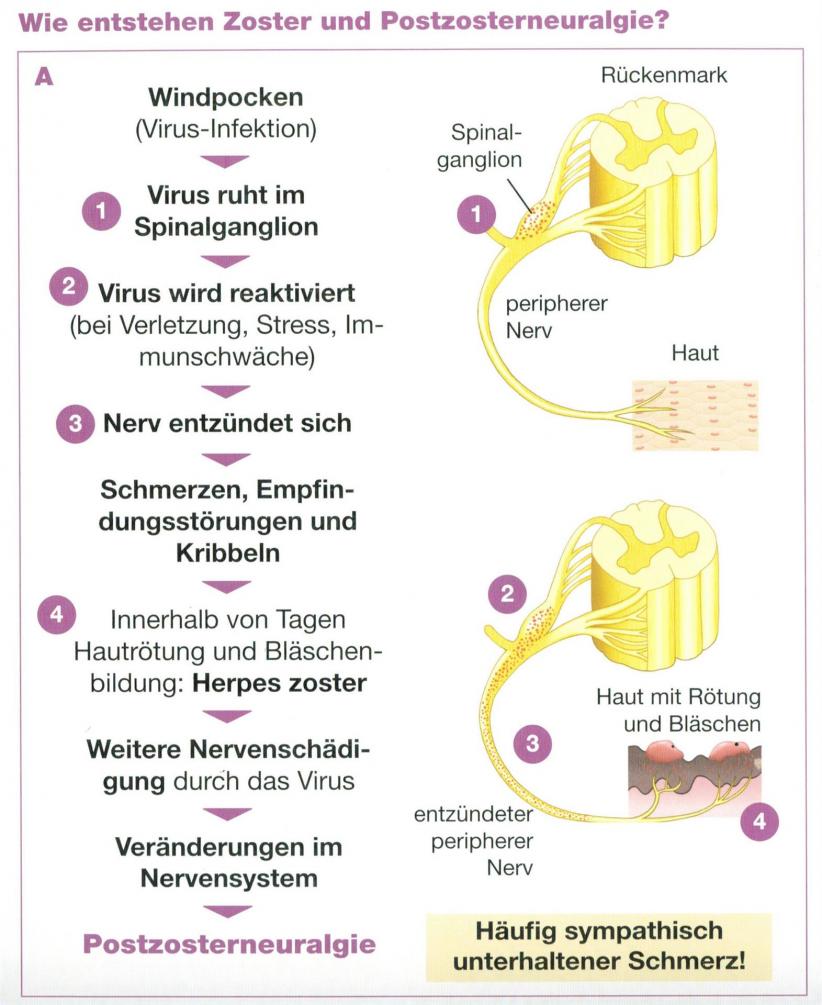You are here: Home » Diagnosis » Pain » Post-Zooster-Neuralgia
Post-Zooster-Neuralgia
Symptome
Symptoms
Sensibility disorder
Unpleasant discomfort which typically appears on both sides and starts at the feet.
Tingling, numbness, burning
Coordination disorder
Disorder in the transmission pathway from proprioreceptors to the brain. These receptors are responsible for the sense of position. Patients are not able to walk straight with closed eyes.
Paralysis
Peripheral, atropical
Mostly symmetrically
Vegetative nervous system
Changes of the skin. Eg. over or underproduction of sweat
Disfunction of the Gaster, Intestine or bladder
Erectile disfunction
Limitation of Mydriasis (pupillary dilatation)
Causes
A Polyneuropathy can be understood as a damage of multiple small nerves. In the beginning the isolating agent oft her nerves the myelin gets damaged which leads to a slower transmission or even a failure of transmission eg. from pain receptors. This can also lead to a functional disfunction of the nerves.
Most common causes:
Diabetis 30- 39 %
Alcohol 11-12 %
Guillain-Barré syndrome 6 %
Toxics besides alcohol ( mostly drugs 0,9- 6%)
Infections 5,4 %
Vasculitis 3- 4 %
The diagnosis always relies on the typical anamnesis and the patients discomfort. Due to an body examination we can see that the patient suffers from a decreased sensation for vibrations. This can be easily seen if we get a tuning fork in contact to the patient’s ankle. If it comes to walking disorders this can be explained by a defect of the transmission pathway from proprioreceptors to the brain.
Blood examination
We can perform a blood examination in our medical office where we have a special look on:
Hemogram, blood- glucose level, HbA1, Vit. B, liver and kidney parameters, antibodies.
Further diagnostics
Examination of the nerval transmission ability via electrophysiology. If we initiate an electrical stimulation of a nerve we can measure the degree of the stimulation on another part of the body where the same nerve has an innervation. Due to the strength and the time until we receive the stimulation we can conclude about the transmissionabilities of the nerve.
Leitlinie zur Diagnostik 2012
The prognosis gets dramatically better if we are able to find the origin of the discomfort so we can perform an etiological treatment instead of only treating the symptoms. If the nerve is not able to recover completely it is possible to perform a further treatment to bring back most of the life quality. It is nonserious to promise that the patient won’t experience any pain after the treatment because this is nearly impossible. In most of the cases it is possible to limit the pain in such a high degree that normal life is possible without any limitations.
If the disease is based on a specific cause it is possible to treat the origin exept of only treating the symptoms.
Infections: Treatment with antibiotics
Alcohol: no drinking
Vitamin deficiency: Vit. B1 &B12 + folic acid ingestion
Diabetis mellitus: optimization of the blood- glucose level. In addition we can treat with acupuncture and Vitamins
If the discomfort can not be improved or it is not possible to find to causing agent we can offer a drug therapy which shows very good chances of healing. We take 3 different drugs into accout.
Antiepileptics (Gabapentin, Pregabalin)
Antidepressants (Amineurin)
Opiates
Strips with local anesthetics
The painful area can be treated with strips which provide a continuous release of local anesthetics.
Chili strips:
A further treatment possibility are chili strips. The patient’s needs to come to our pain center every 3 months where we apply a chili strips on the painful area for 1 hour.
Schmerzschrittmacher
Bei Versagen all dieser Optionen bieten wir einen Schmerzschrittmacher an. Mehr dazu HIER und hier:
Leitlinie: Epidurale Rückenmarkstimulation zur Therapie chronischer Schmerzen


